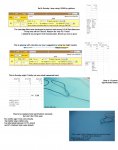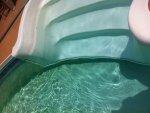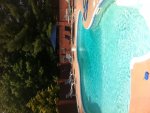- Apr 28, 2008
- 19
Hello folks,
I have just done my second complete test using the TF100 4/27 & 4/28/2008. Great kit though I would say a nice booklet one can read about the different issues each test addresses would be a nice addition to the kit. I bought the kit specifically for the calcium hardness issue I know I have. I have a 25,000 gal gunnite pool redone last year. I am running a Hayward D.E. 7220 and a Polaris eight hours a day. Had the sides pumiced with a scale removal chemical and then backwashed, added water and GLB Sequa Sol (54 oz first time around) to the pool and pH up to bring the pH up, shock to get the clorine up which were both down on a normal test kit the day before the TF 100 arrived. I then let the pool circulate for a day, the 26th. Here are the results of the tests, by date. Each test was taken at noon from the same place in the deep end of the pool and three hours after system started circulating and Polaris crawling around.
4/27 FC: 4.5 CC: 0 TC:4.5 pH: 7.3 T/A: 110 CH 430 CYA 70
4/28 Added water and about 20oz of GLB SequaSol Let pool circulate most of the day before I took test.
4/28 FC: 4 CC: 0 TC:4.0 pH: 7.3 T/A:110 CH 440. I did not take a CYA test this day.
If anyone can give their opinion about getting the calcium hardness down, a sequestering agent you might have experience with or something else you know will work. I'm in Thousand Oaks California so the heat is already 95+ and the sun is intense, so I know I'm going to be adding water almost every day for at least the next few months. Thanks to anyone who might be able to shed some light or offer suggestions.
Best,
Thomas
I have just done my second complete test using the TF100 4/27 & 4/28/2008. Great kit though I would say a nice booklet one can read about the different issues each test addresses would be a nice addition to the kit. I bought the kit specifically for the calcium hardness issue I know I have. I have a 25,000 gal gunnite pool redone last year. I am running a Hayward D.E. 7220 and a Polaris eight hours a day. Had the sides pumiced with a scale removal chemical and then backwashed, added water and GLB Sequa Sol (54 oz first time around) to the pool and pH up to bring the pH up, shock to get the clorine up which were both down on a normal test kit the day before the TF 100 arrived. I then let the pool circulate for a day, the 26th. Here are the results of the tests, by date. Each test was taken at noon from the same place in the deep end of the pool and three hours after system started circulating and Polaris crawling around.
4/27 FC: 4.5 CC: 0 TC:4.5 pH: 7.3 T/A: 110 CH 430 CYA 70
4/28 Added water and about 20oz of GLB SequaSol Let pool circulate most of the day before I took test.
4/28 FC: 4 CC: 0 TC:4.0 pH: 7.3 T/A:110 CH 440. I did not take a CYA test this day.
If anyone can give their opinion about getting the calcium hardness down, a sequestering agent you might have experience with or something else you know will work. I'm in Thousand Oaks California so the heat is already 95+ and the sun is intense, so I know I'm going to be adding water almost every day for at least the next few months. Thanks to anyone who might be able to shed some light or offer suggestions.
Best,
Thomas




